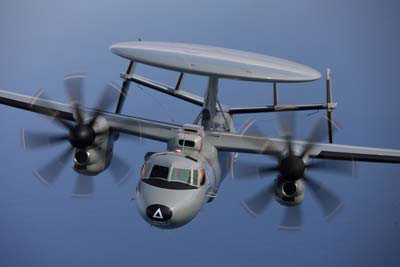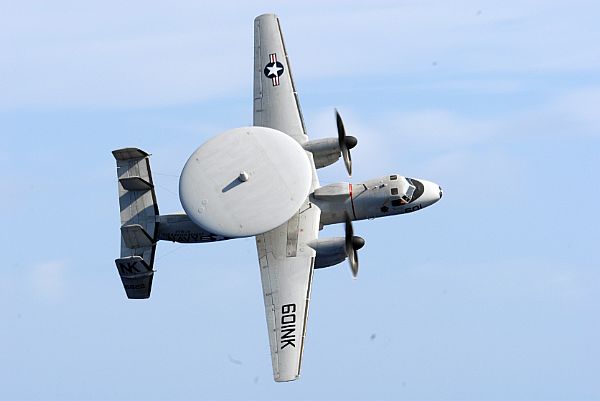E-2D Advanced Hawkeye
The E-2D Advanced Hawkeye, using the E-2C Hawkeye 2000 configuration as a baseline, is slated to feature a state-of-the art radar with a two-generation leap in capability, as well as upgraded aircraft systems that will improve supportability and increase readiness. Using this capability, the E-2D is intended to provide advance warning of approaching enemy surface units, cruise missiles and aircraft, to vector interceptors or strike aircraft to attack. It is also intended to provide area surveillance, communications relay, search and rescue coordination and air traffic control.
Essentially a new aircraft, the E-2D Advanced Hawkeye fundamentally differed from the previous E-2C Hawkeye. While the aircraft's outward appearance remained nearly identical, the mission system was completely redesigned to accommodate new radar, antenna, workstations and displays, as well as a new cockpit layout. Going beyond the single-purpose "glass" cockpits of modern aircraft, Northrop Grumman engineers designed displays that would allow either the pilot or co-pilot to participate as a fourth mission system operator. Navy operator input was been obtained to guide these designs. Other planned features of the Advanced Hawkeye include terrain avoidance systems and global air traffic management system enhancements.
The SDD program also focused on reducing production and total operational support costs. For example, some of the structures on previous Hawkeyes were built-up from individual sheet metal parts. Subsequent designs looked to replace these with single-piece machined parts to reduce both cost and the time needed to construct the subassemblies and mate fuselages. Two-level maintenance concepts, coupled with automated system test capabilities, were being explored to reduce total ownership costs.
The aircraft was designed to meet airborne early warning, surveillance, battle management and theater missile defense needs, as the Navy worked toward its Sea Power 21 concept in support of Joint Vision 2020.
In December 2001, the U.S. Navy took a significant step when it awarded Northrop Grumman a $49 million pre-System Development and Demonstration contract and, in July 2003, the $1.9 billion SDD contract itself for the next-generation Advanced Hawkeye. When the program started in 2003, none of the key technologies were mature.
Under the SDD contract, Northrop Grumman, its radar subcontractor, Lockheed Martin and antenna manufacturer Randtron Antenna Systems (a division of L-3 Communications), were developing a completely new radar and electronically scanned array antenna. The system as planned was to give the Navy far greater threat detection capabilities over land and water, with greater range and precision than any similar system at that time and was the foundation for the Navy's theater air missile defense function.
Initial construction for the E-2D Advanced Hawkeye began in early April 2005. A "Keel Start" ceremony was held on April 25, 2005 at the Northrop Grumman facility in St. Augustine, FL, for the next-generation E-2 aircraft, the E-2D Advanced Hawkeye. After an October 2005 design review, according to the Government Accountability Office, the project had met best practice standards.
The Northrop Grumman E-2D design team, which includes in addition to Lockheed Martin and L-3 Randtron, BAE Systems, Raytheon and Rolls-Royce, was awarded a $2 billion system development and demonstration contract. The first test aircraft, whose keel-start was celebrated in April 2005, was one of two to be built under the contract. The second will be started later that year. Flight testing was scheduled to begin in 2007.
Advanced Hawkeye's planned new communications systems would make it a major node in the Navy's FORCEnet information/decisions grid, enabling it to integrate and deliver key information and surveillance data, fuse decision data and provide forward control and communications capabilities. The E-2D is intended to provide the enhanced airborne command and control and expanded surveillance umbrella that will be a foundation of Sea Power 21.
The SDD program was to lead to a multibillion-dollar Advanced Hawkeye production program. The Navy was, as of late-April 2005, scheduled to receive 75 E-2D Advanced Hawkeyes with the first flight of the Systems Development and Demonstration aircraft scheduled for 2007, and delivery to the fleet in 2011. Production was scheduled to begin in 2010.
A GAO report in March 2007 showed that delays had occured in the maturation of the critical technologies, though backup technologies were available. Usage of the backup technologies would have most likely degraded aircraft performance and not allowed for future system growth. Flight testing with the critical technologies was hoped for the end of FY07, in keeping with previous timelines. In the report a decision about low-rate initial production was to be made by 2009, with the hope that production would commence in March of that year. At the time the US Navy program office insisted that the equipment continued to be low risk with added design complexity stemming from the need to create common standards among the multiple subcontractors.
Between the 2007 and 2008 GAO assessments of the E-2D AHE, the program reported an increase in its baseline procurement cost due to, among other factors, the addition of one aircraft to the program's procurement budget and an increase in the program's material cost estimate. One of the E-2D AHE's four critical technologies was mature. Between assessments, two of these technologies had continued to mature as the program had completed high-fidelity laboratory testing. Although the design met best practice standards at the time of the October 2005 design review, continued increases in the number of required drawings indicated that the design might not be stable. The program office reported in March 2008 that the design was 93 percent complete, but system integration activities had the potential to result in additional design changes.
One of the E-2D AHE's four critical technologies, the space time adaptive processing algorithms, was mature. By March 2008, two additional technologies, the rotodome antenna and the power amplifier module UHF transistor, were approaching maturity as the program completed high-fidelity laboratory testing. The program office anticipated that all four critical technologies would be fully mature through mission system flight testing, which was scheduled to begin at the end of 2007. The program planned to complete a Technology Readiness Assessment in late FY08 in support of the low-rate initial production decision.
The program office reported that 93 percent of total drawings are complete to the GAO for a report published in March 2008. However, continued growth in the number of required drawings indicated that the design might not be stable. The number of required drawings had increased by 39 percent between 2007 and 2008. The program attributed the increase in drawings to, among other things, releases of wiring diagrams, wiring adjustments due to system maturation, and engineering changes that apply to multiple aircraft platforms including the E-2D AHE. This increase in drawings meant that the program had completed only 53 percent of planned drawings prior to the design review. The program office anticipated that 100 percent of the drawings would be complete by the planned start of production in March 2009.
The program office reported that all components were operational in the system integration laboratory in September 2007, and that the first development test of a fully integrated prototype would take place in early 2008. Without the benefit of a systems integration laboratory or a fully integrated prototype prior to entering the systems demonstration phase, the GAO reported that the program increased the likelihood of additional design changes and that problems might be discovered late in development when they would be more costly to address.
In response to the March 2008 GAO assessment the Navy stated that the E-2D program was executing to the approved acquisition program baseline plan, had met all major program events on schedule, and was on track to meet future major program schedule events including the operational assessment in FY08 and the low-rate initial production decision in FY09. Regarding design stability, the growth for E-2D unique drawings was 13 percent. The additional 26 percent of drawing growth included global engineering orders common to the E-2C and C-2A. The E-2D System Integration Laboratory was stood up between critical design review and aircraft test activities as per NAVAIR system engineering best practices and had been an invaluable resource to the program to date. The Navy had chosen not to fund integration of aircraft manufacturing statistical process controls due to the maturity of the 30-plus years of E-2 production history.










